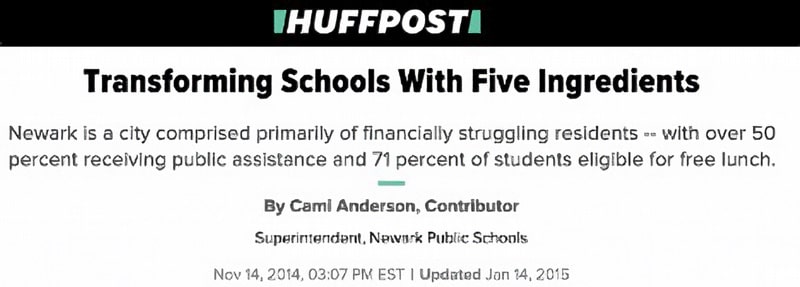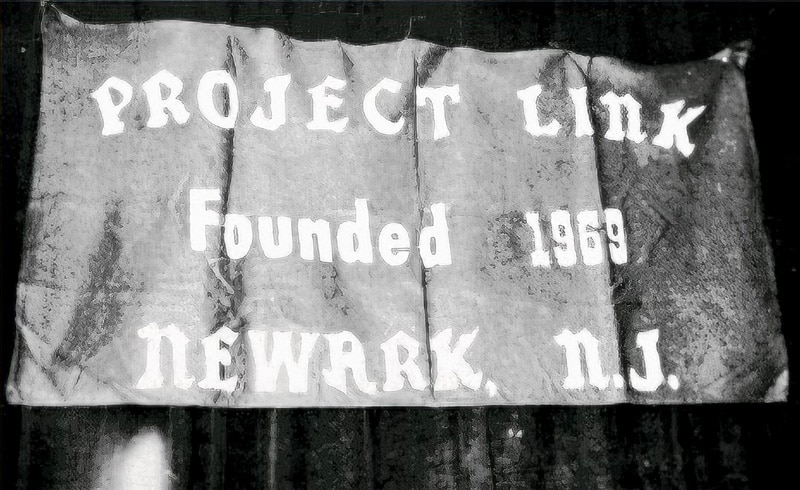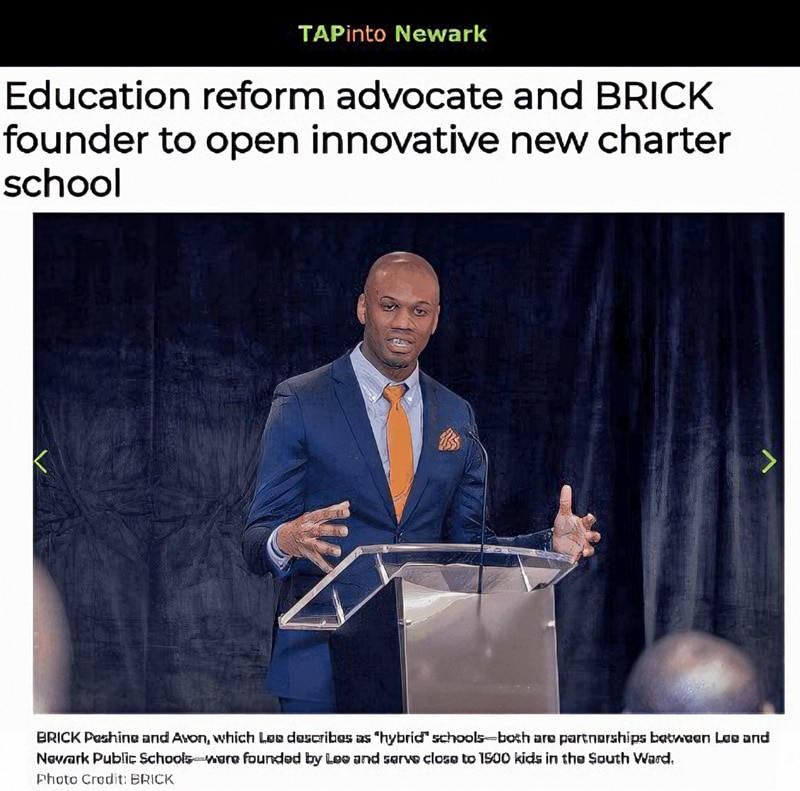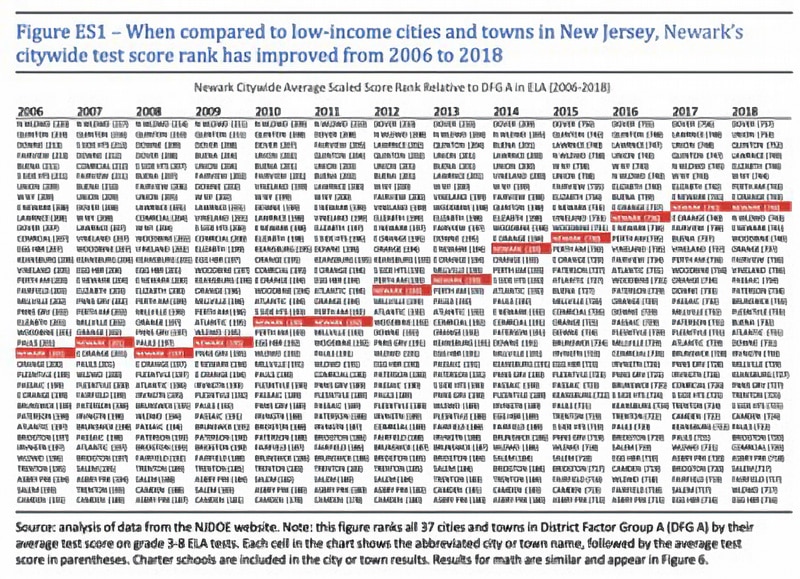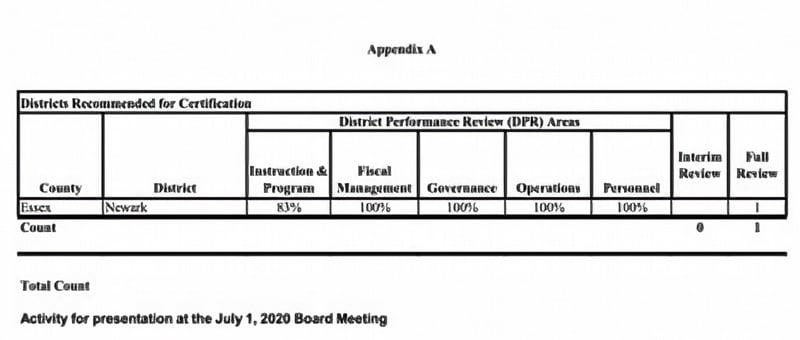Newark Chapter 8: Compelling Research Demonstrates Unprecedented Improvement as an Improved District Regains Local Control
The first visit that Newark Superintendent Cami Anderson made to Alexander Street Elementary School, as she wrote at the Huffington Post in November of 2014 …
… had a profound impact on her.
I cried the first time I visited Alexander. The conditions of the school were that depressing. In the majority of the classrooms I visited there was no explicit, let alone rigorous and skillful, instruction occurring. Crumbling paint, dirty restrooms, and buckled floors reminded me of something out of a Jonathan Kozol book. The principal was filing papers in his office, and when I challenged the state of teaching and facilities, he seemed to have accepted the staggering lack of quality as an intractable fact — “This is a tough neighborhood”. I couldn’t believe it. A radical solution was needed; it was simply unconscionable that we allowed students to attend a school that was overtly squandering their extraordinary potential. We simply cannot accept poverty as a passport to terrible schools.
Rather than making Alexander Street one of the schools the district would close down, though, Anderson had a different idea. She approached Brett Peiser, the CEO at Uncommon Schools about whether the organization would be willing to lead a turnaround effort at Alexander Street. During an interview with author Richard Whitmire at The 74 …
… Peisner described the beginning of Uncommon’s new level of partnership with the district.
In December 2013, Cami Anderson who was then the superintendent of Newark Public Schools, called us to see if we would be willing to take over a district school that was struggling. In many cities, the policy usually was to close that school down and what Cami wanted, instead of closing down the school, was to ask will you continue to play the part that you’re playing in Newark by not just opening up new schools as new charter schools, but also helping turn around a district school that might be struggling. It was right before the winter holidays and I remember thinking to myself that there’s no way that we’re I’m going to be able to convince our leaders that this is something they can take on seven months later when the school year was going to begin. But after a number of conversations, I asked the school leaders in Newark and at Northstar and they were unanimous. They said if we can help, we can, and if we can help, we should.
Every family who had previously attended Alexander was guaranteed a seat in the new incarnation of the school. Many were found to have appallingly low skill levels. As recounted in an article that appeared three years after the turnaround began …
… the vast majority of students at the school lacked even base capacities in literacy and numeracy.
Early on, the entire staff learned what it was up against. At a gathering in the school auditorium, the principal, Juliana Worrell, asked the third- and fourth-graders to count to 100 by 2’s. After the number 16, the only voices that could be heard were the staffers — the students couldn’t go any farther.
Determining the students’ skill levels was a severe challenge, as staffers had to keep switching to more remedial testing materials. Fourth-graders were unable to understand phonics and were reading at a first-grade level.
School Principal, Juliana Worrell started by reforming the school’s culture, keeping all students and teachers together in the school’s auditorium for the first few weeks of school. It allowed the school to adopt the rituals and traditions that Uncommon was known for.

That proved the first step on the path to academic success. Within just one year, the new teachers at Alexander Street, many of whom were experienced educators who had come from other Uncommon Schools, had helped the school double the percentage of students achieving academic benchmarks, and within just three years, the school was exceeding average achievement levels for all schools in New Jersey.

By the fall of 2019, the school had become a national showcase of the progress that is possible within urban schools when the power of chartering is wisely leveraged. In a “Back to School” segment on the Today Show …
… where the show’s hosts …
… had the chance to share their passions with students …
… and where students had the chance to share their passions in return …
… Alexander Street’s transformational progress over the past five years was made plain for all to see.
These were the host’s comments at the top of the segment:
Hoda Kotb: [We had the chance to join} the elementary school kids and Newark New Jersey’s North Star Academy.
Craig Melvin: A few years ago it was one of the schools that were faltering. Many of those kids there were struggling to read and struggling to write.
Al Roker: That’s right but in 2014 it was taken over by the charter school network Uncommon Schools and today North Star is one of the highest-performing schools in the entire state
Here they are at the wrap-up afterward:
Hoda Kotb: The teachers are so impressive …. I couldn’t believe how they could take like a raucous room full of kids in the cafeteria and literally, the principal walked in there and went like this, and you should have heard a pin drop. I’d never seen anything like that …
Craig Melvin: We should also point out: That school? One of the highest college graduation rates of any school in the country. They pride themselves on getting kids, largely low-income, to college.
Carson Daly: I’ve got kids in school and no knock on their schools, I don’t think I’ve ever been more impressed by a school.
These were comments made about a school that earlier in the decade had literally brought its superintendent to tears.
But the progress at Alexander Street was by no means the only headway that was made by charter schools between 2014 and 2019.
This was also the period when Project Link …
… one of Newark’s oldest education organizations, and the organization from which James Verrilli made his decision to create Newark’s first charter school in 1995, was approved to open its own charter school by the New Jersey Department of Education.
In short order, it was making headlines for the positive impact it was making as a charter school.
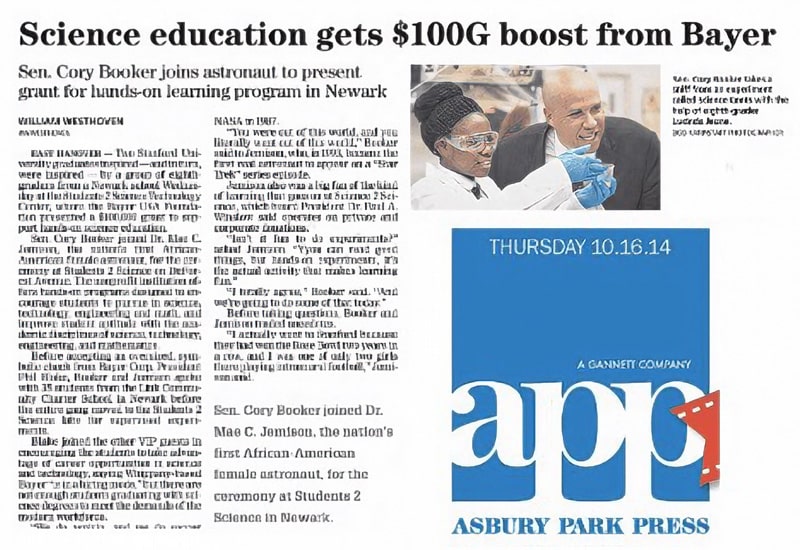
This was also the period when KIPP New Jersey embarked upon a plan to greatly expand its offerings in Newark.
And it was the period when Brick, the nonprofit that had proven so successful operating Avon Elementary as a district school, decided to open a charter school as well.
Clearly, there were moments when the charter school sector’s progress became controversial and highly visible, like when state legislators proposed a moratorium on charter school growth in New Jersey in 2015 …
… leading to large numbers of charter school parents and other supporters loudly registering their opposition.
And, the instances when the state acted assertively to close underperforming charter schools …

… also generated controversy.
But generally, in comparison to the level of acrimony and controversy that had accompanied the years immediately after the Zuckerberg gift announcement, the charter schools made relatively quiet and profound progress.
Evidence first began to merge in 2016 that Newark’s new charter schools were generating impressive results.
By the end of the decade, further research emerged confirming that charter schools were improving student outcomes for large numbers of historically underserved students.
These were the conclusions of the CREDO study coming out of Stanford in 2019.
In both reading and math, Newark charter school students made stronger gains than the state average in all three growth periods of 2015-16, 2016-17, and 2017-18.
Within Newark, charter schools exhibited stronger growth than district schools in reading in all three growth periods. In math, charter schools made greater progress than district schools in 2015-16 and 2017-18, while no significant difference in growth was found in 2016-17.
Research coming out of Boston University was even more emphatic.
I find that enrolling in a Newark-participating charter school leads to large improvements in a student’s math and English language arts (ELA) test scores, on average. Students appear to maintain these positive test-score effects over time. The magnitude of the impact of attending a Newark-participating charter school is comparable with that found in previous research on charters in Boston and Denver. To place the result into context, attending a Newark-participating charter school has a larger effect than 80% of other educational interventions that have been recently studied using an experimental design.
Most encouraging of all, new studies began showing that both charter schools and district schools were improving.
Indeed, the story began to emerge that, relative to other school districts in the State of New Jersey serving similar student populations, Newark was surging ahead.
Across the same time horizon, other research from Bellwether Partners …

… showed another unprecedented trend beginning to emerge: the fact that, after generations of enrollment decline, the number of students served in Newark Public Schools was actually growing.
Indeed, for the first time since the 1980s, Newark public schools were shown to be serving more than 52,000 students.
It positioned the school district, after a quarter century of state control, to return to be governed by the locally elected school board. Nearly all press accounts covering the state’s decision to relinquish control of the district highlighted the significant progress that the district had made while under state control.
With the district improving slowly but steadily in recent years, the state board of education is expected on Wednesday to approve a plan that would ultimately give Newark control again over its public schools with their almost $1 billion budget and 55,000 students …
Newark’s schools have improved — the high school graduation rate is now 77 percent versus 54 percent in 1995; on state tests, the district now ranks in the top quarter of comparable urban districts; low-performing schools were closed while charter schools expanded. The district is retaining more of its best teachers, and fewer of its least effective ones.
During the same board meeting that the state finalized the transfer of authority of Newark schools back to the local school district …
… the state also certified that Newark had become “a high-performing school district.”
Twenty-five years earlier to the day, district administrators at Newark Public Schools had made headlines regarding their desperate attempts to block reform efforts despite the volumes of evidence that had emerged regarding the district’s “rat-infested buildings” where clearly ineffective teaching at a massive scale was leaving vast numbers of student unable to demonstrate base proficiency on state-mandated tests.
Ultimately, resistance from the status quo was overcome, and reform efforts were allowed to proceed, unleashing a level of progress over the next quarter century that demonstrated the potential that chartering has to move public education in urban settings from a circumstance of profound peril to one of unprecedented promise.
…
